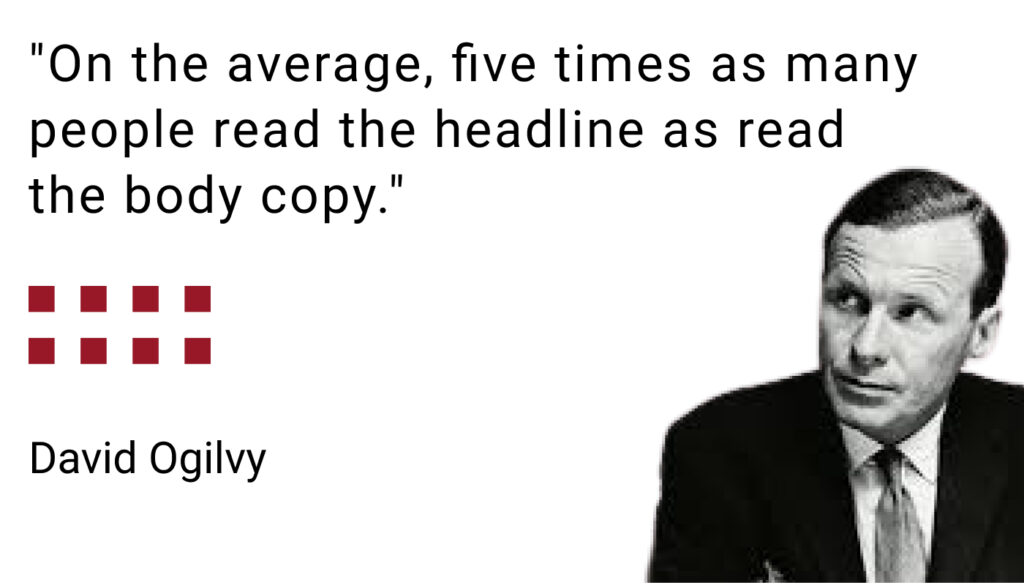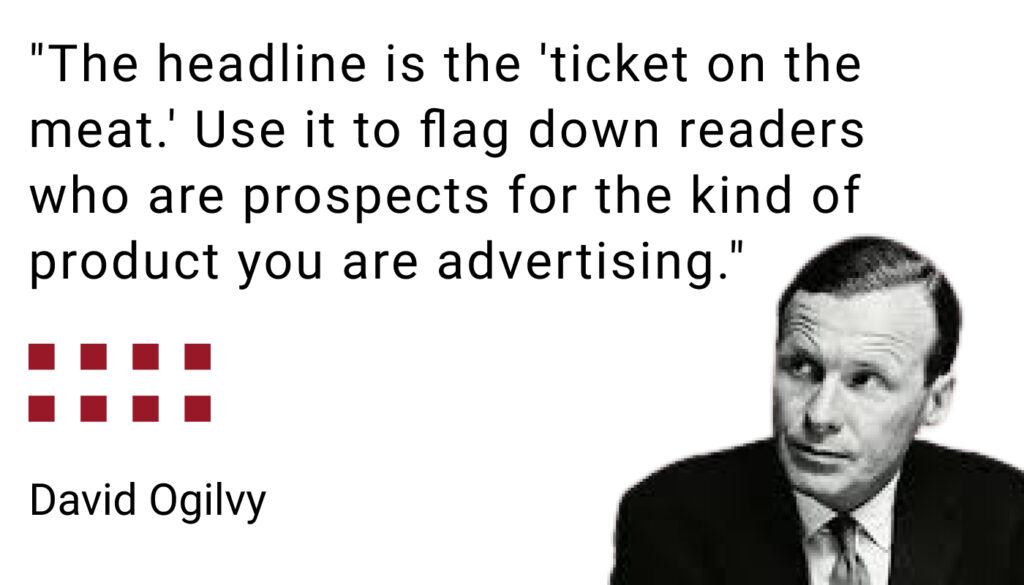Summary
Benefit-oriented marketing headlines are a strategic tool in content marketing. They effectively engage audiences by addressing their practical and emotional needs. Marketing headlines that feature benefits are more than just attention-grabbers; they resonate deeply with readers, promising value and delivering impact. To maximize effectiveness, all your marketing headlines should be clear, benefit-focused, tailored to support your buyers’ journey, and tested for performance. Many benefit headline examples are included in this post. Adapting to trends and using data-driven insights are crucial for staying relevant in the dynamic digital landscape. I’ve also included a section about subheads, the headline’s wingman. This post concludes by reviewing additional headline styles and offering suggestions for their use in marketing to support the buyer’s journey.
Headlines are the gatekeepers of your content. A skilled writer will spend as much time on the headlines as they do on the content. Catchy headlines draw readers into the content you’ve created, or they don’t.
But what gives a headline that undeniable pull?
That’s where the power of benefit headlines comes into play.
Let’s dig in.
The Magnetic Pull of Benefit-Oriented Marketing Headlines

The right headline is a siren song to potential readers, promising them something irresistible. Benefit-oriented headlines do this by focusing on what the reader stands to gain. These headlines don’t just attract—they captivate.
Equally, a carefully targeted, benefit-oriented headline will repel the wrong readers. It’s a little-understood truth that to be effective, marketing needs to attract the right people and repel the wrong people in equal measure.
The Psychology Behind an Effective Headline
Why do catchy headlines work?
It’s all about psychology. Benefits tap into the reader’s intrinsic motivations and needs. They promise what the reader seeks: an answer, a solution, or a way to improve their situation. The promise of a benefit is a potent attention-capturing device. A benefit in a headline is what makes the headline catchy.
Anatomy of a Marketing Headline: What Makes Benefits Stand Out?
A headline with benefits often contains power words that create a sense of urgency or excitement. These headlines are not just labels for articles. They are promises or statements that speak directly to the reader’s self-interest.
Crafting Your Hook: Starting With the Reader in Mind
When you write a headline, start by slipping into your readers’ shoes. We call this outside-in marketing. What ignites their interest? What are their deepest desires? What event or events caused them to start looking for a solution? That’s your hook.
Having a journey map and a customer avatar helps with this. A benefit is relative. What’s important early in the buyer’s journey may not be the key closer to making a decision. The customer avatar tells you what to say and how to say it, while the journey map tells you when to say it.
Identifying Your Audience’s Core Desires
Every audience has a pulse you need to feel. By identifying your audience’s core desires, you can tailor your headlines to speak directly to what matters most to them. Remember, you are competing with a massive amount of digital noise. Your feature articles are more likely to be seen if they tap into a core desire, not just seen but felt.
The Art of Addressing Reader Benefits Upfront
Don’t bury the lead. Addressing the reader’s benefits early in your headline will help it break through the noise and be seen by your readers.
A benefit first headline is especially important with SEO. If someone is searching for content based on a benefit keyword, you want the benefit keyword to appear early in the headline.
The Power of Clarity in Headlines
A clear, benefit-oriented headline will break through the digital noise like a hot knife cuts through butter. Don’t try to be clever. Clever requires thought. You don’t want them to think about what you mean. You want them to grasp the meaning without thought and anticipate the next headline. Deliver the core message with clarity.
How Clear Benefits Break Through the Noise
In a world brimming with information, a clear benefit in your headlines will be a light that invites readers to your content. They are looking for what you are saying. Clarity makes finding your content more accessible. A clear, plain-spoken headline is a good headline.
Why Your Readers Prefer Benefits Over Features

Features tell.
Benefits sell.
Benefit headlines attract by addressing the ‘why,’ while feature headlines get lost in the ‘what.’
It’s that simple.
You want the reader to understand what’s in it for them instantly. Benefits do this. On the other hand, features require thought. The reader needs to think about what the feature means to them, parse the features, and consider how they might solve their problems.
Readers will gravitate to the value that benefits promise.
You want readers to think about what the content means to them. You don’t want them trying to figure this out.
Writing for Wider Reach: SEO and Benefit Headlines
You may have heard about the recent algorithm update that emphasizes ‘useful’ content. SEO isn’t just about search engines—it’s about real people and what they’re searching for. Benefit-oriented headlines resonate with both. Benefits are useful. Features? Not so much. The title tag (the headline) is very important for the search bots. Benefit headlines tell the bots that your content is useful.
Keywords that Click: How SEO and Benefits Are High-Value Partners
You create discoverable and engaging headlines by weaving keywords into benefit-focused headlines.
As mentioned above, search engines favor useful content that fulfills user intent. Benefit headlines tell the search engines that you’ve designed your content to be useful and satisfy users’ needs.
The Emotional Draw of Benefits in Headlines
Humans are emotional creatures. Purchasing a BMW or another luxury car is not a rational decision.
Benefit headlines speak to the heart as well as the mind. They are powerful because they resonate with readers on multiple levels.
Emotional Triggers: Why They Work in Headlines
Include emotional triggers in headlines when this makes sense. Emotional triggers are psychological hooks that reel readers in by resonating with their experiences, fears, and aspirations.
Emotions are powerful.
Building Connections Through Benefits
By highlighting benefits, you establish a connection with a reader that goes beyond the transaction. This happens because benefits solve readers’ problems, and this is what they are looking for—solutions. This builds a connection, which builds trust.

Trust is vital for long-term relationships. We created a handy infographic listing the five relationship marketing principles. When you subscribe to our list, we will happily send you the infographic as a PDF.
Testing and Perfecting Your Headlines
Crafting the perfect headline is an art but also a science. Powerful headlines require refinement. Testing different headlines will help you understand what resonates best with your audience. Trust your judgment, but trust your customers more. They will tell you what’s working through their actions.
A/B Testing: Learning from Headline Variations
Through A/B testing, you can compare headlines to see which performs better with your customers, giving you concrete data on your audience’s preferences. Judgment is cool and all that, but data rules.
There are many free tools for assessing headlines. My favorite is Coschedule’s Headline Analyzer. There’s also a handy Chrome extension.
The Metrics that Matter: Analyzing Headline Performance
Analyzing the performance of your headlines goes beyond just counting clicks. It’s about understanding behavior and engagement. It’s important to assess whether or not the headline is attracting the right people.
The First Impression: Headlines on Social Media

Social media is the frontline of engagement. Your headline is the first, and sometimes only, impression you make on a potential reader scrolling through their feed. You have but a fleeting moment to attract a prospect into your funnel. Don’t squander the opportunity. Use a benefit headline to be noticed.
A headline with a strong benefit is more likely to go viral because it strikes a chord that resonates with the shared desires of a broader audience. When your headline taps into a universal benefit, sharing becomes almost reflexive.
Platform-Specific Strategies for Benefit Headlines
Each social platform has its own unique pulse. Tailoring your benefit headlines to match the platform’s vibe can make the difference between blending in and standing out. Don’t be afraid to poke the pain. The PAS copy framework is popular for a reason.
Learning from the Best: Writing a Headline Like Picasso

Learn from what you see. The great artist Pablo Picasso said, “Good artists copy, great artists steal.”
Take time to dissect the best-performing marketing headlines in the digital space. These are the ones that have stopped thumbs in their tracks and compelled clicks.
Analyzing the top-performing headlines within your niche can uncover patterns and strategies that resonate most with your specific audience.
What We Can Learn from Viral Headline Hits
Viral posts are viral for a reason: they resonate with what your audience is looking for. Analyzing how a viral post resonates with the customer’s needs is a treasure trove of insights. Viral posts teach you about timing, cultural trends, and the art of crafting a message with impact.
The Role of Urgency and Exclusivity in Headlines
Incorporating elements of urgency and exclusivity can transform a good headline into a great one, compelling readers to act now rather than later.
Urgency and exclusivity in headlines create a psychological push that can lead to immediate engagement. When paired with a clear benefit, this push becomes even more persuasive.
Urgency and Exclusivity in Benefit Headlines – Caveat Emptor
Beware of false claims. Readers will see them for what they are, Bro Marketing, and your authenticity and trust will pay the price.
Incorporating Testimonials and Social Proof in Headlines
Testimonials and social proof aren’t just for the body of your content. They can also amplify the impact of benefit headlines.
Leveraging Testimonials for More Compelling Headlines
A headline that includes a testimonial carries extra weight. It’s proof before the promise and a great way to have the reader lean into your content.
The Credibility Boost: Using Social Proof Effectively
Social proof in headlines is another credibility booster. It suggests that the benefits promised are not just possible—they’re probable. Real people have experienced your product or service and are willing to talk about it. Social proof is headline gold.
Testimonials and social proof are so important we wrote a blog post about them: Testimonials for Websites – Use Testimonials More Effectively.
The Length and Punch of Benefit Headlines
The length of your headline can either support or sabotage its impact. Striking the right balance is key to maintaining its punch.
How Long Should Your Benefit Headline Be?
Brevity often wins, but not always. The best length for a benefit headline is what it takes to deliver the message with maximum impact using the fewest words.
There are also SEO implications to consider. Ensure the core message is in the first 60 characters to avoid losing it when a search engine truncates the headline for the results page.
A headline should be as long as it needs to be, but no longer.

Subheads: The Marketing Headline’s Wing Man
Each word in your headline should earn its place. Finding the balance between brevity and impact can be a challenge. This is where the subhead, the benefit headline’s wingman, joins the party.
The Art of the Subheadline: Expanding on Benefits
Subheadlines are your second chance to hook the reader. You can use them to expand on the benefits introduced in the headline. Subheads are a great way to offer a bit more depth without overwhelming.
Detailed vs. Direct Subheadlines: Striking the Right Balance
While subheadlines provide more room for detail, they should still be direct and concise. Find the balance between being informative and becoming verbose.
Consider the Visual Impact of Subheads
Making the content easy to consume is the sixth way to engage a reader in six seconds or less. Using “H” tags correctly for headlines and subheads is essential for SEO. “H” tags help readers and search bots instantly understand their relative importance when scanning an article.
Using Numbers and Data to Highlight Benefits
Numbers and data can serve as proof points in your headlines, offering concrete reasons for readers to trust and delve deeper into your content. This is why the popularity of listicle posts (55%) is second only to how-to posts (76%). This also explains why subject line testing tools used by email marketers always lift the score when a number is present in the subject line. They have the data to back this up. It’s the same for numbers in benefit headlines.
Quantifying Benefits: Numbers Attract Readers
When you use numbers to quantify the benefits, you make them real. Numbers provide a tangible and instantly understandable glimpse into the value that awaits, giving the headline credibility.
Data-Driven Headlines: Combining Facts with Benefits
Data-driven benefit headlines (numbers) stand out because they blend the persuasive power of benefits with the authoritative weight of facts.
Numbers bring credibility to the benefit claim, which builds trust.
The Future of Headline Writing: Finding Trends
Headline writing is an evolving art. Staying abreast of trends ensures your content continues to capture attention as interests and mores change.
Tracking Headline Performance
As algorithms and behaviors change, so do the strategies for headline effectiveness. What worked isn’t necessarily what’s going to work. Don’t just be impressed with a LinkedIn post with thousands of engagements and comments; analyze what the writer did, especially how they crafted the headline.
Basically, to stay ahead, you must anticipate and adapt to the emerging trends shaping how benefit-oriented headlines are crafted, received, and perceived by audiences. These posts tell you what’s working now. Effective marketing headline writing is a continuous process of adaptation and refinement.
Engagement Metrics: How Marketing Headlines with Benefits Drive Action
The true test of a headline’s efficacy lies in its ability to drive action. Engagement metrics tell us not just who’s listening but who’s taking action.
Click-Through Rates: The First Measure of Success
Click-through rates (CTRs) offer a first look at performance. A high CTR indicates that a headline is not just being seen; it’s being acted upon.
Beyond Clicks: Measuring True Engagement from Headlines
But clicks are just the beginning. CTRs can be a vanity metric. Lots of clicks, especially if you are using Pay Per Click media, that don’t convert to sales or some other form of meaningful engagement don’t help. Real success is what happens after the click. You want to assess how readers interact with your content after the headline has done its job. Are you getting clicks from the right people?
The Narrative Arc: Telling a Story Through Headlines

Every headline hints at a story.
A benefit headline invites the reader into a journey by crafting an introduction, an opening line to a greater narrative.
People love stories. Stories are an effective way to deliver your message in no small part because people will read them.
The marketing headline is the first impression.
Beginning with a Bang: The Marketing Headline as a Story Opener
The best headlines open with a bang. They set the scene for the story that unfolds, compelling readers to dive into the narrative headfirst.
How a Benefit Headline Sets the Stage for Content
A well-crafted headline doesn’t just attract attention; it sets expectations. It primes the reader for the following content, ensuring coherence and continuity.
Cross-Platform Consistency in Headline Messaging
In our multi-platform world, consistency is vital. Your headlines should use the same style or tone of voice and carry the same weight and promise, no matter where they appear.
A cohesive message across channels strengthens your brand’s voice and ensures your message isn’t diluted or lost in translation.
For example, if you use a headline in an ad or social media post, be sure the headline on the destination page aligns with and compliments the headline that stimulated the action. Do this, and you will get engagement. Don’t do this, and your traffic will bounce.
Tailoring Your Headline Approach for Different Platforms
While maintaining consistency, it is critical to tailor your headlines to each platform’s nuances and play to each platform’s different segments, strengths, and audiences.
For example, Facebook generally has an older audience than Instagram. What’s a benefit for an older demographic may not benefit a younger audience. Adjust your headlines according to the audience that’s likely to see them.
Beyond Benefit Headlines: A Brief Look at the Other Headline Styles
While benefit-driven headlines are incredibly powerful for capturing attention and interest, they are just one type of headline in the modern marketer’s toolkit. From questions that provoke curiosity to authoritative news-style announcements and urgent calls to action, there are many headline formulas you can use to engage your audience.
This section will introduce nine other popular headline styles that can complement benefit headlines as part of a well-rounded content strategy. For each style, we’ll provide a brief definition, examine what makes it effective, and provide some examples so you can learn by seeing the style in action. Whether you need to instill a sense of scarcity, build credibility through testimonials, or simply deliver a punchy command, having a collection of headline techniques will ensure you have the perfect hook for any marketing message.
The How-To Headline
These headlines promise to teach the reader how to do something by providing instructions or a process. They are common for tutorials, guides, and advice articles. How to headlines should be your go-to technique for mid-funnel marketing content
Example: “How to Boost Your Metabolism in 5 Easy Steps”
The Question Headline
Question headlines provoke thought and draw readers into a conversation. They often address the reader directly and can create a sense of curiosity or challenge. Question headlines are effective in top-of-funnel content.
Example: “Are You Making These SEO Mistakes?”
The Number or List Headline
The number or list headline, sometimes called a listacle, numerically lists out the key points, tips, reasons, etc., that will be covered in the piece (e.g., “7 Ways to Improve Your Putting Game”). They set clear expectations and promise easy-to-digest, skimmable content.
Example: “10 Tips for Crafting Perfect Email Campaigns”
The Urgency or Scarcity Headline
Creating a sense of urgency or scarcity can compel readers to act immediately, making these headlines effective for promotions and special offers. An urgency or scarcity headline is commonly used for lower-funnel content where you guide the prospect to a decision. Authenticity is important, and this style can be risky if you aren’t careful.
Example: “Hurry! Only 3 Days Left to Claim Your Free Trial”
The News Headline
These headlines have a news/announcement style and are effective when the content features announcements or includes timely information. News headlines are great for top-of-funnel content as they attract interested prospects just starting their journey.
Example: “Introducing the Latest Advancement in Renewable Energy Technology”
The Command Headline
Sometimes, you want to be bold. Command headlines are bold, direct headlines that tell the reader what to do using forceful language and verbs. They can be powerful motivators if used sparingly and will be effective in attracting prospects seeking a confident resource. Understand your best customer avatar to be sure the command headline will be a good fit.
Example: “Ditch the Gym Membership – Start Your Home Workout Today”
The Reason Why Headline
These headlines justify why the reader should care or take action by providing rationale and multiple reasons. These headlines are persuasive because they provide rationale and justification for an action. They often follow a list format and give multiple reasons or explanations.
Example: “5 Reasons Why You Should Start Meditating Today”
The Testimonial Headline
These headlines leverage the power of third-party endorsements by quoting praise from a customer or authority figure. Testimonial headlines provide reasons to believe, making your offering more relatable and trustworthy.
Example: “‘This Software Saved Our Business’ – CEO of X Corp”
The Comparison Headline
Comparison headlines position your product or service against a competitor. This style of headline communicates that your product or service is the superior choice.
Example: “Comparing Meal Delivery Services: Which One is Right for You?”).
The Secret Headline
Secret headlines pique curiosity by promising exclusive or insider information that is typically not known. These headlines are very effective when communicating with prospects who are deep in the funnel or exiting customers; “Good customers expect to be rewarded.“
Example: “The Hidden Negotiation Tactics Top Realtors Use to Get the Best Deals”).
By expanding beyond benefit-driven headlines, you open up a full arsenal of engagement tactics and attention-grabbers. Each of these 10 additional headline styles—from listicles and questions to secrets and comparisons—has its own unique psychological appeal to pull readers in.
Headline styles can be mixed and matched depending on your content’s purpose and the audience’s situation. Don’t rely on just one or two styles. Have a strategic mix of styles and approaches to use in different situations and with different audiences. (More on this follows below.)
The key is always putting your audience first. Who are they, and what are they looking for? With creativity and an understanding of what motivates your particular segment, you can craft headlines that are truly irresistible – driving more engagement, trust, and sales for your business.

Crafting Headlines for the Buyer’s Journey
While benefit headlines are powerful for highlighting the value proposition and driving conversions, they have even more impact when paired strategically with other headline styles at different stages of the buyer’s journey. By understanding your audience’s mindset and needs at each phase of their journey, you can craft a headline sequence that guides them toward a purchase decision without feeling tricked or manipulated. When I described the different headline types and also included some suggestions for where in the buyer’s journey the style could be used.
For example, let’s say you’re marketing a new personal finance app. In the early awareness stage, potential customers are just realizing they have a need for better money management. At this point, a thought-provoking Question Headline in a Google Ad could work well to pique their interest, such as “Are Hidden Fees Draining Your Bank Account?” The ad’s CTA would then lead to an informational landing page with an educational How-To Headline like “How to Take Control of Your Finances in 3 Simple Steps”. This page could offer a downloadable budgeting guide to capture leads. Then, the prospect can be added to your list and nurtured through the mid-funnel.
As prospects move into the consideration phase, they start actively researching solutions. Here, a Comparison Headline in a Facebook Ad like “Why Our App Beats Mint for Easy Budgeting” could grab the attention of mid-funnel researchers. The ad would link to a landing page with persuasive Number/List and Benefit Headlines, such as “10 Reasons XYZ App is the Smarter Way to Manage Money – Save Time, Avoid Fees, and Achieve Your Goals Faster”. The Offer on this page could be a budgeting masterclass or an email course.
Finally, for decision-stage buyers who are ready to purchase, an email with an Urgent Headline like “Don’t Miss Out: Get 50% Off XYZ App, This Weekend Only!” can be the perfect motivator when paired with a checkout page that reiterates a strong Benefit Headline (“Ready to Take Control of Your Financial Future? Start Saving Smarter Today”).
The key is to align your headlines with each stage of the buyer’s journey, moving from interest to consideration and, finally, decision. This strategic progression feels helpful rather than manipulative because you provide the right information and offers at the right times based on the buyer’s needs to make an informed decision. Of course, having a Journey Map is vital for this application.
The specific headline styles you choose will depend on your unique product, audience, and marketing channels. But by thoughtfully combining different headline formulas across the customer journey, you can create a cohesive and compelling narrative that naturally nudges prospects forward.
You want to use headlines and subheads as trust-building interactions that guide prospects to the best solution for their needs—not to deceive anyone. With a customer-centric approach and a mix of authentic, well-matched headlines, you can craft more effective marketing campaigns that drive results and create value for your customers and your business.
Wrap-Up: The Takeaway on Benefit-Oriented Headlines
In conclusion, benefit-oriented marketing headlines are more than just a writing tactic; they are a strategic tool that, when used effectively, can transform the reach and impact of your content.
Benefit headlines work because they speak directly to the reader’s practical or emotional needs, offering clear, compelling reasons to engage with your content.
Let’s look at this post’s headline: Better Marketing Headlines: Why Benefits Perform. It leads with a benefit, better marketing, and it teases what the reader can expect from the post.
While benefit headlines are the best, they aren’t the only solution. Familiarize yourself with all the headline styles, what they are, and when to use them. And don’t forget o test and assess. Headlines are a big thing and as such, an ideal place to use A/B Split testing.
In this post, I unpacked the art and the science behind crafting marketing headlines that perform. Benefit headlines are more than a savvy copywriter’s trick; they pull readers into a story because they resonate more deeply with readers. They promise value, which delivers an impact that goes beyond mere words. By focusing on benefits, your headlines will drive performance and, ultimately, deliver on your marketing investments.
Mastering Content Writing: Creating Content That Ranks with Keywords Everywhere
Supercharge your content writing with Keywords Everywhere’s ChatGPT widget templates.
Why Your Business Can’t Afford to Ignore Content Marketing
This article explains content marketing from top to bottom.
Save Time and Effort: How to Create Engaging Content by Talking About Your Products or Services
Save time and effort by recording audio to create engaging content.
Author: James Hipkin
Since 2010, James Hipkin has built his clients’ businesses with digital marketing. Today, James is passionate about websites and helping the rest of us understand online marketing. His customers value his jargon-free, common-sense approach. “James explains the ins and outs of digital marketing in ways that make sense.”
Use this link to book a meeting time with James.

